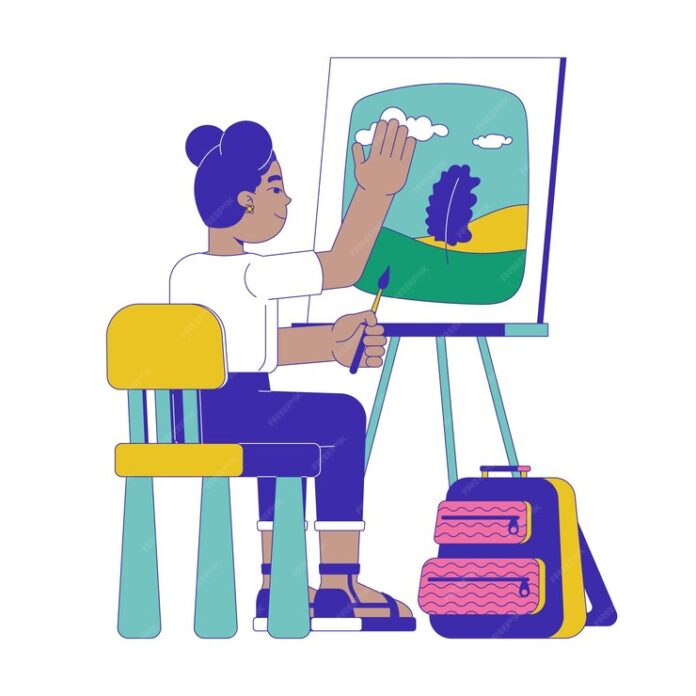Art has long been a mirror reflecting the complexities and beauties of human experience. It’s not just about the strokes on a canvas or the notes in a symphony; it’s about what lies beneath—lessons that can transform our personal and professional lives. In this blog, we will explore how art holds invaluable lessons from the art and how these lessons can be seamlessly integrated into our everyday lives, sparking creativity, resilience, and a broader perspective.
Understanding the Impact of Art
Art’s influence permeates every facet of life, shaping cultures, histories, and societal values. While some might view art as merely decorative or entertaining, its real power lies in its ability to evoke emotions and provoke thought, often acting as a catalyst for change. Throughout history, art has been a silent yet persuasive force in leading revolutions, shifting perceptions, and even toppling regimes.
Take, for example, Picasso’s “Guernica.” This masterpiece didn’t just captivate audiences—it rallied them. Created in response to a tragic event during the Spanish Civil War, it painted a stark picture of suffering and chaos, compelling viewers to confront the horrors of war. It showed how art could distill complex societal issues into powerful, universally understood messages.
In today’s world, art continues to challenge norms and inspire movements. Street art, digital installations, and performance pieces often highlight societal issues, urging us to rethink our values and actions. Whether in a gallery or on a sidewalk, art remains a vital tool for communication and reflection, reminding us of our shared humanity and the need for empathy.
Lessons in Creativity
Creativity is the lifeblood of innovation, and nowhere is creativity more celebrated than in the world of art. Whether through painting, sculpture, music, or dance, artists continuously push the boundaries of what’s possible, inviting us to do the same in our personal and professional lives. This creative mindset can be a powerful tool for problem-solving and innovation.
Consider the process of creating art. It requires imagination blended with discipline. Artists frequently experiment, make mistakes, and adapt—skills that are equally crucial when developing new products, services, or strategies in business. By observing how artists work, we can learn to approach problems more flexibly, considering multiple solutions rather than a single right answer.
Incorporating artistic practices into daily routines can enhance creativity in any field. Activities such as sketching ideas, brainstorming without judgment, or viewing regular tasks through an artistic lens can break down conventional thought patterns, opening doors to novel solutions and groundbreaking ideas.
Resilience and Perseverance

The path of an artist is rarely easy. It’s filled with obstacles, rejections, and failures, yet these challenges often forge stronger, more resilient individuals. Artists teach us about perseverance—the kind of perseverance that keeps you painting even when your work isn’t selling, or composing when your music isn’t heard.
An excellent example is the story of Vincent van Gogh. During his lifetime, van Gogh sold only a few paintings and struggled with mental illness. Despite facing numerous setbacks, he continued to create, producing over 800 works of art. Today, his paintings are celebrated worldwide, symbolizing how resilience can eventually lead to recognition and success.
This lesson from the art is invaluable in any career. The ability to persist in the face of adversity, to learn from failures, and to maintain passion and dedication are vital traits for achieving long-term goals. By emulating the resilience of artists, we can become more adaptable and determined, ready to overcome any hurdles on our path to success.
The Power of Perspective
Art isn’t just about the artist’s viewpoint; it’s about inviting others to see through different eyes. By engaging with art, we can practice seeing the world from diverse perspectives, a skill that’s increasingly important in today’s interconnected world. This shift in perspective fosters empathy and understanding among people with varied backgrounds and experiences.
For instance, when you look at paintings from different cultures, like traditional Japanese ukiyo-e prints or vibrant Mexican murals, you gain insight into the values, struggles, and joys of those societies. This exposure helps break down stereotypes and encourages open-mindedness, essential for harmonious collaboration in diverse teams.
Incorporating this lesson into our lives means actively seeking out and appreciating different viewpoints. Whether it’s through travel, reading, or conversations with people from different backgrounds, broadening our perspective enriches our understanding and enhances our interactions, both personally and professionally.
Implementing Art Lessons in Everyday Life
While understanding art’s lessons is insightful, integrating these lessons into daily life is where true transformation occurs. Here are some practical tips on bringing art-inspired habits into your routines:
- Schedule Creative Time: Dedicate a portion of your week to a creative outlet. It doesn’t have to be traditional art—try writing, cooking, or even gardening. This creative time can rejuvenate your mind and spark new ideas.
- Practice Mindfulness Through Art: Engage with art to cultivate mindfulness. Visit a local gallery, attend a live performance, or simply sit with a piece of music. Allow the experience to pull you away from daily stressors, fostering a sense of calm and focus.
- Reflect and Share: After experiencing art, take time to reflect on its impact. What emotions did it stir? How did it shape your perspective? Sharing these reflections with others can deepen your understanding and strengthen connections.
By weaving art’s lessons into our lives, we nurture a richer, more dynamic outlook that enhances our personal and professional experiences.
Conclusion
The lessons from art are not confined to galleries or stages; they permeate every aspect of our lives, offering fresh perspectives, fostering creativity, and building resilience. By engaging with art, we gain tools for navigating challenges, cultivating empathy, and driving innovation.
